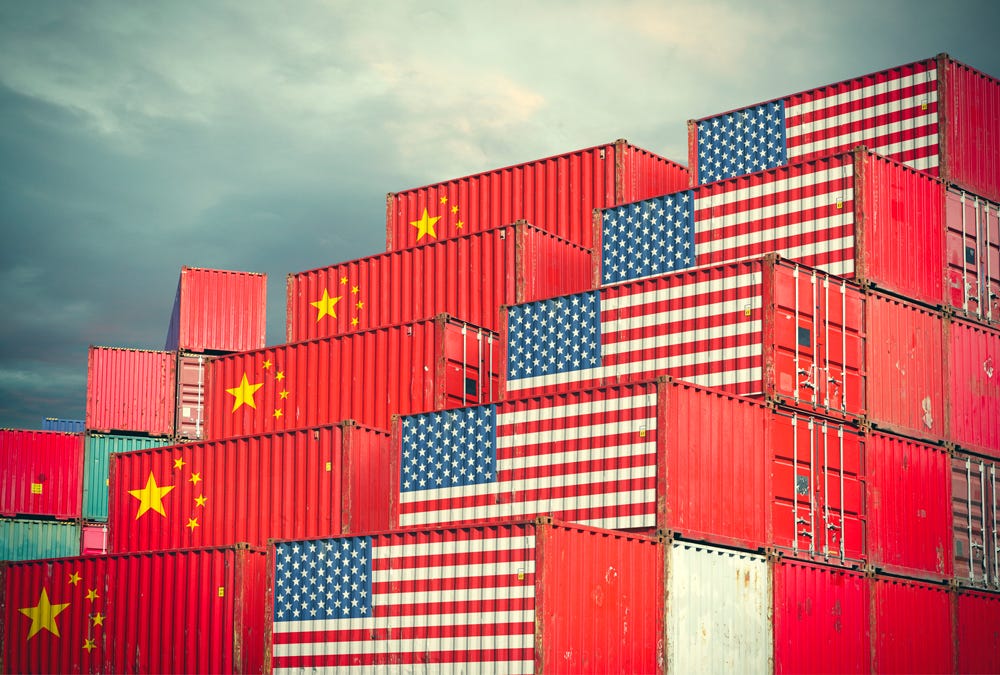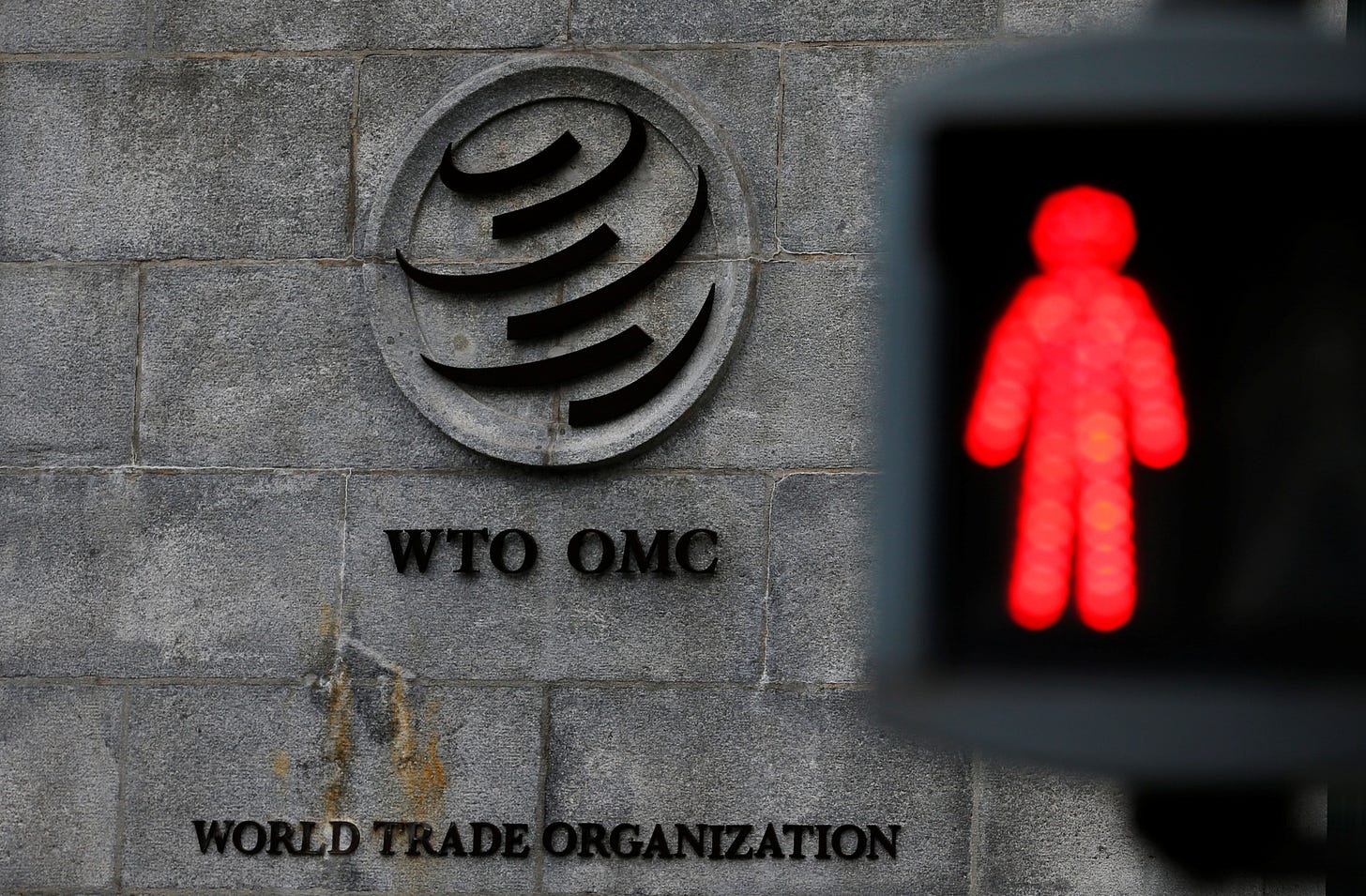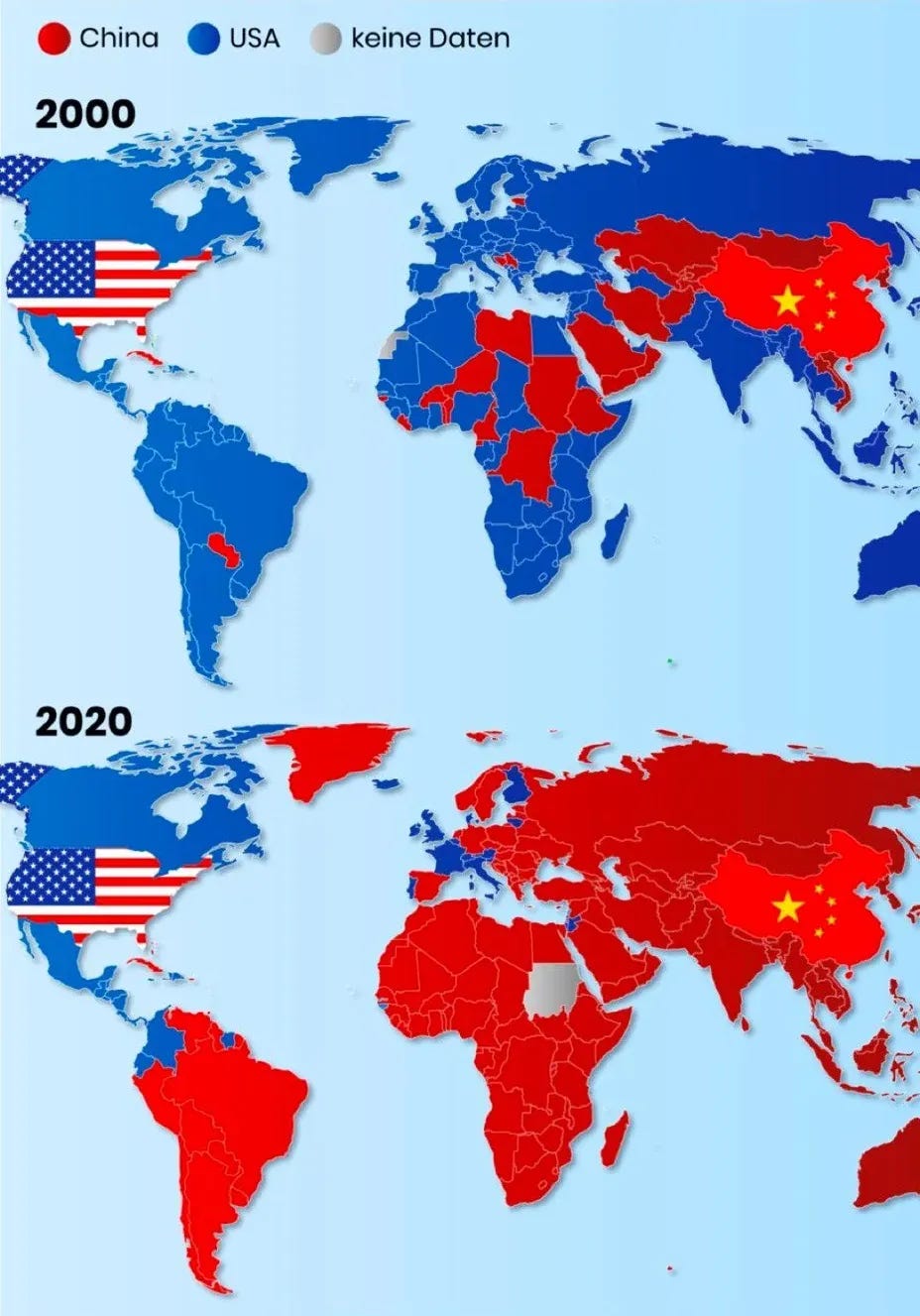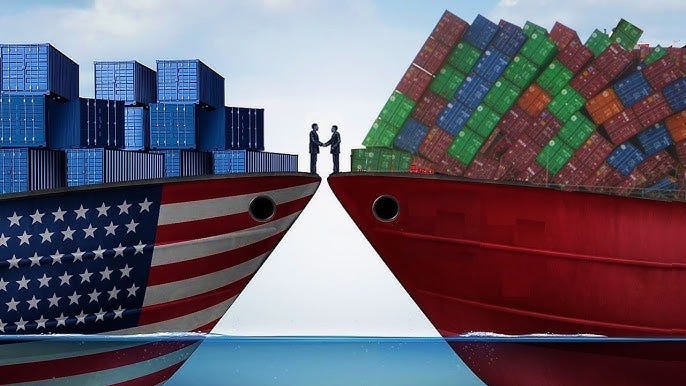World Trade Disorganization: How the US Is Undermining Its Own Legacy
📡 In a move that has trade wonks, diplomats, and just about everyone who likes predictable rules scratching their heads, the Trump administration last week decided to halt US funding to the World Trade Organization (WTO). Yes, the very institution the United States helped create to promote free trade is now on Washington’s chopping block.
What’s going on here? Is the US quitting the WTO entirely, or just pinching pennies?
🧐 What Exactly is the WTO, and Why Should We Care?
⚖️ To understand the uproar, we need a quick refresher on the World Trade Organization. Think of the WTO as the global referee for trade—it sets the rules for international commerce, settles disputes when countries think others aren’t playing fair, and generally works to keep tariffs and trade barriers low
Founded in 1995, in a period where Western dominance was almost total, the WTO now covers 98% of world trade and counts 164 members.
📌 Why does this matter? Because if every country just did its own thing on trade—slapping random tariffs or bans whenever it felt like it—we’d have chaos. The WTO’s goal is to prevent trade wars and keep markets open.
Members get access to each other’s markets on equal terms (the “most-favored nation” principle) and in return must play by the agreed rules. When disputes arise (and they always do) the WTO’s dispute settlement system is supposed to adjudicate and keep retaliation in check
🕊️ China’s Grand Entrance, Made in America’s Hopes
🌐 Let’s rewind to a sunnier moment in trade history: December 2001, when China joined the WTO. Back then, the US was China’s big sponsor for entry—American leaders truly believed bringing China into the rules-based trade club would be a win-win. President Bill Clinton spearheaded the push, lobbying Congress to grant China “permanent normal trade relations” (PNTR), which was basically a green light for WTO accession
Clinton hailed the House’s approval of China trade terms as “a historic step toward continued prosperity in America, reform in China, and peace in the world… it will open new doors of trade for America and new hope for change in China.”
🔔 The idea (perhaps naïve in hindsight) was that WTO membership would make China play by global trade rules, liberalize its economy, and maybe even nudge its politics in a more open direction.
A top US goal was to lock China into a US-led liberal economic order and transform it from the inside.
And to be fair, China’s accession deal in 2001 was no free ride. Beijing had to agree to massive policy changes: cutting sky-high tariffs, protecting intellectual property, opening markets, and curbing state subsidies
On paper, it was a huge makeover. China’s average tariffs fell from over 30% in the early 1990s to under 8% by the time it joined WTO
Over the next decade, trade between China and the world exploded.
In 2001, China’s goods trade was about $516 billion;
by 2024, it ballooned to $5.98 trillion
Impressive, right? US companies gained access to a vast new market, and American consumers enjoyed an influx of cheap toys, electronics, and $5 t-shirts.
Happy ending for everyone? Not so much
Perhaps the epithom of global trade can be summarized by Ronny Chieng’s 2019 sketch. Check it out below!
🚨 The “China Shock”
🇨🇳 It turned out China was better at gaming the WTO system than changing its own system. While China did embrace trade and became the world’s factory floor, it didn’t exactly turn into the free-market democracy some in Washington had hoped for.
By the 2010s, many in the US—on both sides of the political aisle—were calling China’s WTO membership a bitter pill. A 2018 US government report flat-out said “the United States erred in supporting China’s entry into the WTO” because the terms failed to secure true market reforms in China.
In other words, China kept acting communist (state-owned enterprises, heavy government intervention, selective compliance with trade rulings, economic espionage and intelectual property theft) despite joining the capitalist club. These practices have exacerbated trade imbalances and fueled US frustration with the WTO’s inability to address these issues effectively.
📦 Meanwhile, Chinese imports (super competitive thanks to China’s lower wages and strategic policies) hammered US manufacturing towns. Economists call it the “China shock.” By one estimate, from 2001 (when China joined WTO) to 2011, the flood of Chinese imports cost:
1 million American factory jobs
2.4 million jobs overall when you count all the ripple effects
And it only got worse from there. Whole communities, especially in the US Midwest and South, saw factories shuttered. While Walmart shoppers cheered low prices, many workers felt betrayed by globalization. The shock contributed to a populist wave that, lo and behold, helped fuel the rise of one Donald J. Trump.
Cue the irony: the WTO—which the US midwifed into existence and expanded to include China—became a punching bag in American politics. Critics said it failed to discipline China’s bad behavior (like intellectual property theft or unfair subsidies), and that it tied America’s hands while Beijing cheated.
They weren’t wrong.
By the late 2010s, even some free trade cheerleaders were rethinking things. The rules-based order the US championed was now seen by some in Washington as a global “straitjacket” holding America back from playing hardball with China. And guess who absolutely loved that narrative?
President Trump, of course.
America First, WTO last
🇺🇸 From day one, Trump’s “America First” mantra had a skeptical view of multilateral institutions. Trade deals and organizations, in Trump’s view, were often “bad deals” for the US The WTO was singled out as a “disaster” long before 2025 —as early as 2016, candidate Trump mused about pulling the US out entirely
While a full withdrawal didn’t happen in his first term, the administration found ways to undermine the WTO from within. The most notorious move was paralyzing the WTO’s appellate court in 2019 by vetoing all new judge appointments. Since WTO cases need a functioning appellate body for final appeals, this effectively broke the dispute system’s teeth. US officials accused the WTO judges of overreach, but many saw it as America tossing a wrench into a system that had ruled against it in some trade disputes.
Fast forward to March 2025. President Trump has doubled down on reshaping global trade to his liking. We’ve seen tariff wars (steel, aluminum, Chinese goods, and even a new 25% tariff on imported cars slated for April 2025).
So, what did the administration actually do? At a WTO budget meeting on March 4, 2025, US delegates dropped the bombshell that Uncle Sam is pausing all payments to the WTO budget for 2024 and 2025.
💸 In plain English: the US stopped paying its WTO dues. This wasn’t a loud public announcement, but behind closed doors it sent shockwaves through Geneva. America is (or was) the WTO’s biggest funder, contributing about 11% of the WTO’s 205 million Swiss franc annual budget. Now that money is “on hold.” The official reason? Washington says it’s conducting a top-to-bottom review of spending on international organizations to see if they align with US interests.
It’s part of the broader “America First” audit where anything seen as globalist freeloading might get axed. The timing, of course, is convenient: it’s a way to pressure the WTO for reforms, a nod to the Republican base that loves sticking it to global institutions, and it fits neatly with domestic budget-cutting zeal.
🛂 Not Quite “Goodbye,” But a Serious Snub
🙅🏻 Now, does halting funds mean the US actually left the WTO? No – at least not yet. Withholding dues is a strong-arm tactic, but it’s not the same as formally withdrawing. If the US wanted to fully exit the WTO, it would have to invoke Article XV of the WTO treaty, give a 6-month notice, and likely get Congress involved (since Congress approved WTO membership in the first place)
That’s a whole process, and as of now, the administration hasn’t gone that far. Instead, we have a sort of financial boycott while remaining a member.
However, even this move has immediate consequences within the WTO framework. According to trade officials, if a member doesn’t pay its dues, the WTO can slap them with “administrative measures”—basically escalating penalties that kick in as arrears pile up. As of this pause, the US is now in “Category 1 arrears,” meaning American representatives lose certain privileges at the WTO.
For example, US delegates can’t preside over WTO committees or working groups, and they might even stop receiving some official documents. If a year passes with no payment, the penalties can ramp up (potentially losing voting rights or other benefits).
Is the US aware of the consequences? Absolutly. Is it right to send a message that way? Depends
The United States—one of the WTO’s founding fathers – now joins a tiny list of delinquent members that haven’t paid dues. As of the end of 2024, that list included the likes of Bolivia, the D.R. Congo, Djibouti, Gabon, and Gambia. Not exactly company a trade superpower usually keeps. The US administration is keenly aware of this, and so is the rest of the world.
In plain English: You change or we’e out.
To be clear, the US could still reverse course. In fact, one former US trade official opined that he thinks the US will eventually pay its WTO bill, noting that the administration had even nominated a new US ambassador to the WTO.
Essentially, the Trump administration is just throwing a fit, as it did for all other issues for the past two months.
Ironic Twists and Global Implications
🌏 The strategic irony here is rich. The United States spent decades after WWII building the global trading system—from Bretton Woods to GATT to the WTO—on the belief that American leadership in setting rules would make the world (and the US) more prosperous.
It was the champion of using institutions like the WTO to write the economic rules of the road. And for a long time, that was true: US leadership in the WTO helped open markets worldwide for American companies.
Now, we have the spectacle of a US administration effectively undermining the WTO from within, at the very moment China’s influence in global trade is at its zenith. In recent years, in a wonderfully ironic role reversal, Chinese leaders have often positioned themselves as defenders of the multilateral trading system—at Davos and other forums, China’s President would wax eloquent about the virtues of free trade and global cooperation, implicitly contrasting himself with America’s more protectionist stance. (Of course, China’s rhetoric sometimes outpaces reality—Beijing certainly bends or breaks trade rules whenever convenient—but the optics are striking.)
The below video is of Xi Jinping, China’s president, urging a gathering of multinational CEOs (Mercedes Benz, Saudi Aramco, Toyota, HSBC, FedEx etc.) on Friday to protect global industry and supply chains, A DAY BEFORE the US withdrew funding from the WTO… yikes.
🚦So what happens if the US really disengages or even withdraws from the WTO? Global trade would face a tsunami of uncertainty. Remember those MFN (most-favored nation) benefits? If the US left, it could lose guaranteed low-tariff access to 163 countries’ markets overnight
Other countries could jack up tariffs on US goods at will. American exporters—think farmers, Boeing, tech companies—would suddenly be at the mercy of whatever trade barriers foreign governments felt like enacting.
In short, the US would be shooting itself in the foot while simultaneously removing its shoe (so much for safety).
Even the current funding freeze, short of full exit, dents US credibility. It signals that America’s commitment to rules it once wrote is paper-thin if those rules prove inconvenient. Allies like the EU, Japan, and Canada are deeply worried—they’ve relied on US leadership to uphold the system. If the sheriff skips town, what stops others from flouting the rules? The European Commission President bluntly criticized Trump’s recent tariffs as ‘bad for businesses, worse for consumers’.
Global trade could devolve into a free-for-all of tit-for-tat measures.
🛑 America’s Risky Walk Away
💡 The “America First” doctrine driving this is unapologetic: if a global institution (like the WTO) doesn’t give the US everything it wants, then Washington will go it alone, global consequences be damned. While the rest of the world watches with a mix of alarm, confusion, and a dash of schadenfreude.
Supporters of the move argue the WTO has failed to deal with China’s state-driven capitalism and that US sovereignty is more important than Geneva bureaucracy. Critics retort that this is a self-defeating tantrum that weakens America’s hand, ceding ground to China and undermining decades of stability in global trade.
One irony no one should miss: back in 1999, when anti-globalization protesters were smashing windows at the WTO meeting in Seattle, their rallying cry was that institutions like the WTO hurt workers and undermine sovereignty. Those protesters likely never imagined that a populist US president might one day be effectively siding with their sentiment—albeit for very different reasons.
Where does this end? Perhaps with cooler heads finding a path to reform the WTO – addressing legitimate US grievances (like updating rules for state-owned enterprises and tech subsidies) so that America feels it benefits from the system, rather than is constrained by it.
One could also argue that state subsidies SHOULD in fact become reality again. After all, why shouldn’t a nation be allowed to champion its own companies?









Blue states must look to Europe and the EU for the future of Democracy.